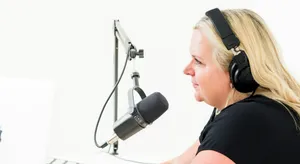Mar 22, 2025
Podcast Marketing Tips: Effective Strategies for Growth

Many podcasters dream of taking their shows to bigger heights. With countless podcasts out there, standing apart might look challenging. Yet with the right marketing plan, it’s possible to grow a loyal audience that keeps coming back for more. Learn more about how to promote a podcast with comprehensive strategies. Podcast marketing isn’t just about sharing audio on social platforms. It’s about building a genuine community, telling a meaningful story, and connecting with listeners in ways that truly resonate. Dedicated tools, like #Podpacer, can also simplify the workflow and keep production on track.
Consistency forms a key part of a solid approach. Learn more about podcast production workflow to maintain a regular schedule. Posting fresh episodes on a set schedule helps listeners know when to tune in. It’s also wise to pinpoint the ideal audience and figure out where they hang out online. That way, every marketing effort can meet them right where they are. Collaboration stands out as well. Cross-promotion with other shows or industry experts can introduce new folks to the content. Engaging with listeners, whether through comments or messages, also fosters loyalty that can go a long way.
These podcast marketing tips act as the building blocks for any show aiming to navigate a crowded landscape. The sections below explore the strategies that can make a podcast more noticeable, fun, and beloved by its followers.
Understanding Your Audience
Knowing who listens is a vital part of any podcast plan. When a show clicks with the right crowd, it can spark real excitement and push folks to share episodes with friends. Focusing on the people who tune in sets the stage for everything else. It might mean boosting downloads or nurturing long-term fans. Every choice in a podcast, from topics to style, grows easier when there’s a clear picture of who’s on the other end of those headphones.
Define Your Target Audience
Start by pinpointing the common interests or problems the show addresses. Imagine the perfect listener, including things like age range, location, and favorite activities. Think about the show formats that appeal to them, the cultural references they enjoy, and the kind of content that keeps them hitting play. Learn more about boosting listenership with unique podcast themes to attract your ideal audience. Having a clear vision of this ideal person shapes every episode’s angle and helps the podcast stay focused.
- Identify the main topic that drives the show.
- Outline the demographics most likely to link with that style.
- Keep an eye out for unique hobbies that might stir curiosity.
- Remain consistent with the themes that speak to the listener’s biggest motivations.
Pinpointing this specific niche provides more than just direction—it’s a way to encourage loyalty. Listeners often get more invested when they see themselves in the conversation. They feel recognized, which inspires them to share the podcast in their own circles. That word-of-mouth boost can be huge, especially for shows looking to gain traction.
Once there’s a basic outline of who might be tuning in, the next step is figuring out their online habits and preferences. Checking out social media groups or online communities is a practical move. It’s possible to see if potential listeners enjoy shorter sessions or longer, detailed chats with guest experts. Observing what gets them talking—like open-ended questions or relatable stories—can help shape future episodes.
Conduct Audience Research
Reading comments or reviews on similar podcasts can be a goldmine of ideas. Folks often share honest feedback when they feel a show misses the mark or truly stands out. By examining hashtags or keywords tied to the main topic, it’s easier to spot trends or common concerns. Learn more about boost podcast SEO tips for discoverability to improve visibility. Surveys can also be sent out to gather direct insights, like what kind of guests they’d prefer or what length keeps them hooked.
- Inspect hashtags or keywords related to the podcast’s main subject.
- Peek at comments or reviews on popular shows in the same space.
- Post open-ended questions in forums or on social media for straightforward responses.
- Create listener surveys for a detailed view of what they like and want more of.
When there’s a good handle on what the audience likes, producing episodes becomes more efficient and fun. Each conversation or story can be tailored to match listener requests. Building that sense of connection strengthens loyalty, which is the backbone of growth. Once the audience is clearly understood, the next step is creating a strong brand that ties all the pieces together.
Building a Strong Podcast Brand
A strong brand involves much more than a stylish logo or clever tagline. It reflects the vibe that listeners experience the moment they see the show’s artwork or hear the host’s voice. When branding is consistent, it builds trust and forms an emotional bond. This feeling can be the reason someone chooses one podcast over another, especially when options seem endless.
Create Memorable Podcast Cover Art
Cover art is like a quick introduction when potential fans are scrolling through directories. A design that pops can make them stop and take a closer look. Simple elements that match the show’s topic can work wonders, as cluttered images might be overlooked. Legible fonts also help, especially since many people browse on smaller screens.
- Use an image or concept that fits the podcast theme.
- Pick fonts that are easy to read, even at a reduced size.
- Get feedback from friends or followers before finalizing a design.
- Maintain a consistent color palette to reinforce brand identity.
A recognizable cover design shows that the host cares about presentation. It’s a chance to communicate the show’s tone before anyone hits the play button. With a bit of testing and input from others, it’s possible to find a look that speaks to the show’s essence.
Craft a Compelling Podcast Trailer
A trailer acts like a preview for anyone who stumbles upon the podcast. Short, lively audio clips can highlight the best moments, whether it’s funny banter or a thought-provoking quote. Including a concise introduction of the host and a simple explanation of the show’s purpose can seal the deal for new listeners.
- Keep the trailer under two minutes to maintain interest.
- Mention the main topics or benefits in a clear, energetic tone.
- Include a snippet of dialogue or a fun moment from a past episode to add personality.
- Share the trailer on social media or in newsletters for added exposure.
When a trailer clearly sums up what the show offers, it’s easier for potential fans to decide if it aligns with their interests. This snapshot of style, content, and pacing helps them see if it’s a good fit. At that point, they might subscribe or keep browsing, but a solid brand identity gives them a reason to stay.
Optimize Your Podcast for Discoverability
Making a podcast easy to find is a game-changer when aiming for new listeners. People often browse directories or type specific phrases into search bars, so setting up each episode with clear, helpful information makes a difference. It might mean adding the right keywords, reworking episode titles, or writing show notes that reflect what’s actually discussed. Platforms rely on these details to match podcasts with user searches.
Utilize Podcast SEO Best Practices
Some folks think search engine optimization applies only to blogs, but a podcast can reap the same benefits. Choosing relevant keywords and weaving them into episode descriptions helps draw more clicks. Even the short summary on a listening app can be a window to attract the right audience.
- Include common search terms in episode titles or descriptions.
- Write concise show notes that reference topics or themes people often look up.
- Add the host name and podcast name to website metadata for extra clarity.
- Provide transcripts or detailed summaries so search engines can index the content more thoroughly.
It helps to stay consistent. When every episode has a descriptive title and a solid block of show notes, those who stumble on a single episode might be encouraged to explore the rest. Some creators use production tools like Podpacer to stay organized as they edit and publish, which can keep everything uniform and easy for platforms to parse.
Choose Descriptive Episode Titles
Episode titles are like mini billboards. They need to be concise but still paint a picture of what’s in store. A playful phrase might grab attention, but it should also include keywords that match the listener’s curiosity. For example, a show on healthy snacks could have a title like “Five Simple Fruit Snack Ideas” so it’s easy to tell what the talk covers.
- Skip one-word titles since they don’t reveal much.
- Use numbers or guiding words like “Tips,” “Ideas,” or “Guide” to spark interest.
- Follow a consistent naming pattern so returning listeners know what to expect.
- Ask friends or colleagues if the title sounds appealing and makes sense.
When each title offers a clear hook, people who scroll through podcast feeds can quickly judge if it fits their mood. That small detail might be the key reason they take a chance on a fresh show. Over time, a pattern of strong, descriptive titles can boost visibility and help a podcast rank better in search results.
Leverage Social Media for Promotion
Social platforms are places where listeners gather, chat, and pass along recommendations. Sharing podcast clips or teasers can spark interest in a matter of seconds. Timing is important since it helps catch people when they’re most active. By focusing on platforms that align with the show’s niche, there’s a better shot at meeting the right audience.
Use Instagram and TikTok Effectively
Both Instagram and TikTok thrive on short, engaging content. Posting a quick behind-the-scenes reel or a highlight from a recent interview can lead curious viewers to check out the entire episode. These platforms lean toward visual content, so catchy backgrounds or captions stand out even more.
- Add subtitles on videos so people can follow without sound.
- Tease future episodes with quick stories or short clips.
- Show listener shout-outs or user-generated posts to build a shared sense of community.
- Experiment with Reels on Instagram or trending sounds on TikTok to reach new eyes and ears.
These lively sites can be playful spaces where a show’s unique vibe shines through. If it’s a comedy podcast, a funny snippet might get someone to tune in during their lunch break. If it’s business-related, a bite-sized tip can demonstrate the host’s expertise. The main idea is to grab attention quickly and create a sense of curiosity that leads to more listens.
Engage with Your Audience on LinkedIn
LinkedIn isn’t always the first platform on a podcaster’s mind, yet it can be valuable for topics related to career growth, industry insights, or leadership. Sharing short recaps of episodes, interesting stats, or guest quotes can pull in a crowd looking for professional development. Prompting discussions with a question also invites comments, which increases visibility in the LinkedIn feed.
- Start a conversation by asking what others think about the episode’s main theme.
- Include notable quotes or facts that encourage readers to learn more.
- Tag relevant guests or partner organizations to widen the post’s reach.
- Attach visuals or short clips for folks who prefer quick content.
When the show covers subjects that professionals care about, LinkedIn can be a direct path to an engaged audience. Over time, it can also help the host build a reputation as a trusted voice in that niche. Combine that with other social media efforts, and there’s a solid strategy for drawing listeners from different corners of the internet.
Collaborate with Other Podcasters
Teaming up with fellow hosts can open new doors for any show. By exchanging guest spots or recommending each other’s episodes, there’s a chance to reach listeners who are already interested in similar material. This approach often benefits everyone involved, especially if the audiences overlap. Done well, it can spark lasting connections and even friendships in the podcasting scene.
Cross-Promotion Opportunities
Cross-promotion is a straightforward idea. One host mentions or features another’s show, and vice versa. This might happen during an episode, on social media, or in a newsletter. Choosing a partner with complementary topics helps, as listeners can seamlessly move from one show to the next without feeling lost.
- Look for podcasters who address similar themes or questions.
- Outline what each side is expected to share, so no one feels shortchanged.
- Include a quick highlight clip that demonstrates the partner’s style.
- Check listener feedback to see if the cross-promotion sparks more downloads.
When done with sincerity, cross-promotion benefits listeners, too. They get personal recommendations from a host they already like, saving time they might spend searching for fresh podcasts. This sense of community can lead to a surge in engagement as well, since fans appreciate it when hosts champion each other.
Guest Appearances and Interviews
Another angle is inviting other podcasters or industry folks to be guests. It’s a chance for fresh perspectives that can spice up the content. At the same time, each guest brings along some of their own audience. Learn more about essential questions for podcast interviews to make your guest appearances more engaging. That can lead to new subscribers for the primary show, especially if the conversation is energetic and packed with insights.
- Plan a structured interview with thoughtful questions that showcase the guest’s background.
- Weave in personal stories or anecdotes that listeners can relate to.
- Coordinate promotion ahead of time so both parties can share the link.
- Offer a follow-up session or bonus Q&A to keep the collaboration going.
These joint efforts can also help hosts gain credibility. By featuring voices from different areas, the show feels more well-rounded. Meanwhile, appearing on someone else’s podcast allows the host to speak to a fresh group of listeners who might otherwise never stumble upon it. Teaming up can quickly turn a small show into a recognized voice in its field.
Utilize Email Marketing
Email might feel old-school, but it’s still a very direct way to speak to dedicated fans. When someone signs up for a newsletter, it shows they’re interested, making them more likely to open updates and actually listen. Emails can also go out on a predictable schedule, which gives people a heads-up on fresh episodes or special announcements.
Start a Podcast Newsletter
A quick email letting fans know about new content can be a helpful nudge. Include headlines, episode links, and a brief teaser of what they’ll hear. By keeping the conversation friendly and personal, each email feels like a casual chat rather than a sales pitch. Learn more about how to write perfect podcast script to create compelling content.
- Include a clear call to action, like asking subscribers to share an episode with a friend.
- Show snippets of guest quotes or surprising stats to spark interest.
- Tease what’s next on the calendar so they have a reason to stay subscribed.
- Encourage fans to reply with feedback or topics they’d like to see covered.
Finding the right frequency is key. Sending emails daily might overwhelm, but monthly might not be frequent enough for a weekly podcast. Experiment with a schedule that suits the show’s releases and doesn’t clutter inboxes.
Create Engaging Email Content
Each message should have a warm tone, as if it’s written to a friend. Including behind-the-scenes updates or personal anecdotes can keep readers interested. Some hosts share amusing mishaps from recording sessions or small milestones, like hitting a certain download count.
- Pose a fun question that subscribers can reply to.
- Thank new readers and let them know about special perks, such as early episode access.
- Add images or clips to make the email more colorful.
- Remind them the podcast is all about connecting, so their feedback counts.
Sending out newsletters that feel genuine leads to closer bonds with fans. Over time, a loyal email list can be one of the biggest drivers of consistent downloads. Pair it with thoughtful social media campaigns or cross-promotions, and there’s a full-circle approach that covers both personal and public channels.
Experiment with Paid Advertising
Sometimes, putting money into ads can speed up podcast growth, especially when there’s a need to reach fresh listeners quickly. Even a modest budget can highlight the show in front of the right group. The trick is to define who should see the ads and track how many clicks or subscribers result from them.
Social Media Ads
Facebook and Instagram ads allow for pinpoint targeting, like focusing on users who follow health and fitness pages if the podcast covers wellness topics. Short videos or static images showcasing the show can grab attention in a busy feed. A direct call to action, such as “Listen Now,” tells people exactly what to do next.
- Offer a free download or a special code in the ad to encourage clicks.
- Keep the text brief so viewers catch the message fast.
- Add subtitles on any video content for better accessibility.
- Send people to a special landing page that explains how to subscribe.
Trying different versions of an ad helps reveal what clicks with the audience. Words, visuals, or the target audience can all be changed. Tracking ad metrics, like cost per click, provides insight on whether the campaign is worth the investment.
Spotify Ad Campaigns
Spotify lets creators run audio ads that play between tracks. This format reaches people who are already in a listening mindset, which can make it more appealing than a random banner ad on a website. A clear, 30-second audio clip can highlight the show’s main hook and prompt a quick search.
- Write a script that names the podcast and key topics.
- Use a friendly, casual tone that reflects the show’s personality.
- Add a short phrase that sticks in the listener’s mind.
- Check download numbers or analytics to measure any spikes after the ad goes live.
Running ads on a platform where podcasts are already thriving might lead to immediate results. Combined with cross-promotions or strong SEO, these campaigns can form a multi-pronged approach that helps a show find its ideal crowd.
Analyze and Refine Your Strategy
Measuring the progress of a podcast is much like checking reviews for a new restaurant. Keeping track of downloads, listener drop-off points, and engagement on social platforms can reveal if the show is hitting its goals. With that knowledge, the host can decide what stays, what goes, and what could be improved for the next batch of episodes.
Track Key Podcast Metrics
Words like “downloads” and “unique listeners” might sound technical, but they give a sense of how many people are tuning in. It’s also helpful to notice where listeners drop off during an episode. If many exit early, it might mean the opening isn’t grabbing them or the episode runs long. Learn more about how to increase podcast listeners with proven strategies.
- Compare metrics for older episodes and newer ones to see if there’s growth.
- Note the average consumption rate to detect any consistent drop-off points.
- Watch social media engagement each time a new episode goes live.
- Gather opinions from reviews or messages to see what folks genuinely like.
These details highlight what’s going right. They can also uncover blind spots. A show might need better editing, shorter intros, or more interactive segments. By understanding listener habits, the host can adapt or shift focus toward topics that spark the strongest reactions.
Adjust Strategies Based on Data
Blueprints are only useful if they’re updated regularly. When a certain episode format earns more downloads, planning future topics around that style can keep people coming back. If there’s a drop in listenership at a certain point, it might help to tighten up the content or alter the pacing.
- Revamp show notes if analytics suggest few people read them or click links.
- Reassess social platforms that aren’t driving results, and maybe try a different approach.
- Refresh branding elements, like cover art, if they don’t seem to draw new fans.
- Lean into the episodes that bring in the most conversation or positive feedback.
By staying open to change, a podcast can stay ahead of shifting trends. It’s not about tossing out everything that’s been done. It’s about taking a close look at what works, then doing more of it. With routine check-ins, there’s always a route to steady improvement.
Conclusion
A standout podcast grows when there’s a genuine bond with listeners, combined with fresh ideas for getting the word out. Setting a consistent schedule is just the start. It helps to fine-tune brand identity, set up straightforward SEO, and tap into the right online communities. Checking metrics regularly uncovers what’s drawing folks in, which lays a path for smart adjustments. Small tweaks, like clarifying episode titles or using Podpacer for smoother episode planning, can lift a show to new heights. By focusing on relationships and meaningful content, a podcast can find a home on playlists everywhere.
Frequently Asked Questions (FAQ):
How do you promote a podcast effectively?
Promote a podcast effectively by understanding the target audience, leveraging social media platforms, collaborating with guests, and utilizing email marketing to reach potential listeners.
How do I get 1000 listeners for my podcast?
To gain 1000 listeners, focus on consistent content production, optimize the podcast for search engines, engage on social media, and team up with other podcasters for cross-promotions. Learn more about how to grow your podcast audience naturally for detailed tips.
Is a podcast a good marketing strategy?
Yes, podcasts can be an excellent marketing strategy because they reach a niche audience, build brand authority, and create engaging long-form content that can be repurposed across channels.
How much do podcasts make per 1,000 views?
Podcast earnings per 1,000 views, known as CPM (Cost Per Mille), can vary widely, often ranging from $18 to $50. The exact figure depends on audience size, engagement, and ad placements.
Related Posts
See All Posts

Social Media for Podcasts: How to Build and Engage Your Audience
Podcasts have become part of everyday routines, offering stories and insights with just a tap. But with so many choices out there, finding t


Mastering Podcast SEO Techniques: A Comprehensive Guide
In a world where podcasts keep growing, getting noticed can feel like a climb. There's a bright side, though. [Learn more about boost podcas


Top Podcast Promotion Strategies for 2025
Plenty of podcast creators hope to stand out in a sea of audio content. With over two million shows available, it's essential to find new wa
No one knows your podcast like Podpacer
Podpacer is the best way to handle your podcast production. Manage your guests, research and plan your interviews, write social media content with one click, all in one place.


